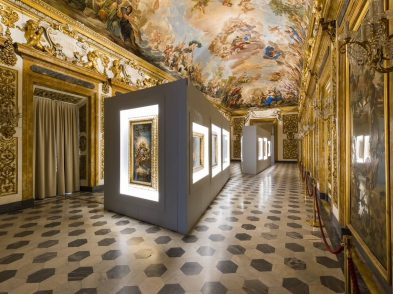
There is no doubting Salvador Dalí’s popularity. His work continues to please, shock and titillate, generating food for thought and queues at the ticket office. The arrival of The Dalí Universe at Palazzo Medici Riccardi is welcome. As does every Dalí exhibition since the Catalan artist died in 1989, it prompts the question, How important an artist was Dalí?
Salvador Dalí has become one of the art world’s greatest brands. Like Warhol and his soup can, the sight of Dalí’s name, spiky moustache and spikier signature are instantly symbolic and widely anticipated.
Like Timex and Swatch, Dalí is synonymous with clocks. Although his have melted and stopped, they supply that rare, single image that encapsulates an artist’s entire story.
But behind his fame and soft watches, was Dalí a serious contributor to the last century’s revolutionary advances in art?
The question arises because his celebrity is so pervasive. Indeed, the personality of the painter, whose work for many epitomises Surrealism, risked obscuring his artistic achievement in his own lifetime.
Appearing in a diving suit at the opening of the London Surrealist exhibition in 1936, he was the centre of excellent publicity. His memorable gesture prefigured performance art.
But as he proceeded to overdress, over-decorate and over-produce, he unfailingly extolled his own importance. His elevation to aristocracy as Marqués de Dalí de Pubol by the current Spanish king may have been the reward for this photogenic self-promotion rather than for his place in art’s highest echelons.
Yet Dalí has a secure place in twentieth-century art history. It was not earned by showmanship, although his flamboyance brought Hollywood-style stardom to modern art. His importance, however, may not lie where it is most expected.

For in 1929, together with fellow Catalan, the filmmaker Luis Buñuel, he made Un chien andalou, a ground-breaking film enduringly influential for its expressive treatment of taboo subjects. Scenes of random violence and primal responses introduced to a wider world Dalí’s ability to distil into astonishing images his preoccupation with paranoia, sexuality and death.
In 1930 came L’Age d’or, a second film that is no less celebrated. Years later, he collaborated with Alfred Hitchcock on the innovative dream sequence in the British director’s psychological thriller, Spellbound.
Dalí’s relationship with cinema is not well known but it deserves to be. Maybe film was influential on the dream spaces he painted, or perhaps the inspiration went in the other direction. Whichever, he was a master of troubled imagery, deeply inspired by the revelations of Freudian psychoanalysis.
He poured this interest into paintings distinguished by warped realism and potent combinations that contradicted his viewers’ expectations. The key element was illusion, what he called ‘eye-fooling,’ fuelled by his rich visual imagination and immense technical sophistication.
His best canvases date from the 1930s, and The Persistence of Memory (1931) has acquired iconic status. The theme of time is represented by several clock faces melting over surfaces adrift in an eerie landscape beside the sea.
Dalí’s own misshapen profile appears like a lifeless, discarded skin in a painting resonant with submerged anxieties. Identities fall apart and material properties reversed. So hard becomes soft and day could be night as ants devour metal as if it were dead meat.
The Parisian poets and painters of Surrealism were fascinated by the Catalan artists stirring, irrational images and by his outlandish behaviour. But he was always an independent figure, apolitical, extravagant and unpredictable. They quickly parted company, but not before he had fallen for Gala, then wife of French poet Paul Eluard and subsequently Dalí’s ever-present muse.
From the 1940s onwards, his celebrity consumed his real creative energy. Now and then, a powerful image did emerge. When his mystical streak combined with forebodings engendered by the nuclear age it produced Christ of Saint John of the Cross.
This painting from 1951, in which a vision of the crucified Jesus hovers above the endangered planet, is justifiably acclaimed. Millions of homes still display it in reproduction.

But this is not the artist that The Dalí Universe celebrates. By no means a revealing examination of a great artist, the exhibition resembles an emporium devoted to the prodigious production and distracted, diluted imagination of the older man. None of his early masterpieces is on view.
Dominated by editions produced late in his career, it leans heavily on excess—in the scale, repetition, hubris and weirdness of the bronze sculptures, for instance—rather than his original inspiration.
Yet this is an equally true portrait of Dalí, although this late work highlights attitudes that overshadowed the painter’s best qualities.
Nonetheless, the exhibition underlines the breadth of his activities. In his final two decades, the Dalian universe comprised illustrated books, graphics, furniture, writing, glasswork and more to meet the demands of a market hungry for the brand. By now the constellation lacked its sun.
The fragile flame of his particular genius was burning low. It never was quite strong enough, even for a life half as long. Dalí the star performer took over. The brand became the mausoleum for his ego.






